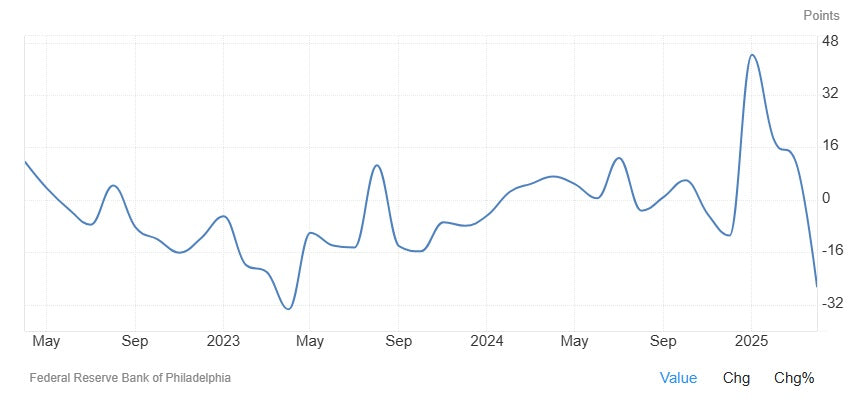Data Breakdown: Philadelphia Fed Manufacturing Index Collapses
Published At: Apr 19, 2025 by
Gareth Soloway

The Philadelphia Fed Manufacturing Index for April came in at -26.4. The forecast had been for 2.2. This is a major miss of consensus and shows manufacturing is in a recession. This likely signals a consumer that is pulling back on spending over economic uncertainty.
Let's explore how the number is calculated:
What it is:
- The Philadelphia Fed Manufacturing Index, often called the Philly Fed Index or formally the Manufacturing Business Outlook Survey (MBOS), is a monthly economic indicator produced by the Federal Reserve Bank of Philadelphia.
- It measures the health and changes in the manufacturing sector within the Third Federal Reserve District, which includes eastern Pennsylvania, southern New Jersey, and Delaware.
- It's based on a survey sent to about 250 manufacturers in this region each month.
- The index is considered a timely snapshot of regional manufacturing activity and is closely watched because it can sometimes provide early indications of broader trends in the national U.S. economy, especially in manufacturing.
How it is Calculated:
- The Survey: Manufacturers are asked about the direction of change in various aspects of their business compared to the previous month. They indicate whether conditions have "increased," "decreased," or shown "no change."
-
Key Questions: The survey covers several areas, including:
- General business activity
- New orders received
- Shipments of goods
- Unfilled orders
- Delivery times from suppliers
- Inventories
- Prices paid for inputs
- Prices received for their own goods
- Number of employees
- Average employee workweek
- Capital expenditures
-
- Index Value = (Percentage of firms reporting an increase) - (Percentage of firms reporting a decrease) Diffusion Index Calculation: The headline index (for "General Activity") and indices for the other components are calculated as diffusion indexes. The formula is:
-
Interpretation:
- A reading above zero indicates that more manufacturers are reporting improving conditions (expansion) than worsening conditions.
- A reading below zero indicates that more manufacturers are reporting worsening conditions (contraction) than improving conditions.
- A reading of zero means the percentage of firms reporting increases is equal to the percentage reporting decreases.
- The index measures the breadth of change (how widespread the change is across firms) rather than the magnitude (how large the change is).
- Seasonal Adjustment: The reported figures are usually seasonally adjusted to smooth out predictable fluctuations related to the time of year.
In essence, the Philly Fed Index provides a quick gauge of whether manufacturing activity in its specific region is generally expanding or contracting based on the collective responses of local manufacturers.




